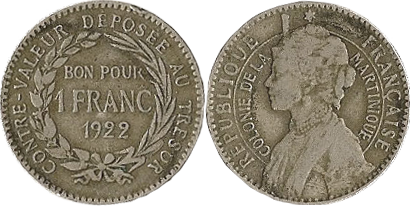Martinique franc on:
[Wikipedia]
[Google]
[Amazon]
 The franc was the currency of
The franc was the currency of
 In 1855, the Colonial Treasury introduced 1 and 5 francs ''Bons de Caisse'', followed by 2 and 10 francs in 1884.
In 1874, the ''Banque de la Martinique'' introduced 5 francs notes, followed by 100 and 500 francs in 1905, 1 and 2 francs in 1915, and 25 francs in 1922. Between 1942 and 1945, a final series of notes was issued by the Banque de la Martinique in denominations of 5, 25, 100 and 1000 francs.
In 1944, the ''Caisse Centrale de la France Libre'' (Central Cashier of
In 1855, the Colonial Treasury introduced 1 and 5 francs ''Bons de Caisse'', followed by 2 and 10 francs in 1884.
In 1874, the ''Banque de la Martinique'' introduced 5 francs notes, followed by 100 and 500 francs in 1905, 1 and 2 francs in 1915, and 25 francs in 1922. Between 1942 and 1945, a final series of notes was issued by the Banque de la Martinique in denominations of 5, 25, 100 and 1000 francs.
In 1944, the ''Caisse Centrale de la France Libre'' (Central Cashier of
Martinique
Martinique ( , ; gcf, label=Martinican Creole, Matinik or ; Kalinago: or ) is an island and an overseas department/region and single territorial collectivity of France. An integral part of the French Republic, Martinique is located in th ...
until 2002. It was subdivided into 100 ''centime
Centime (from la, centesimus) is French for " cent", and is used in English as the name of the fraction currency in several Francophone countries (including Switzerland, Algeria, Belgium, Morocco and France).
In France, the usage of ''centim ...
s''. The French franc
The franc (, ; sign: F or Fr), also commonly distinguished as the (FF), was a currency of France. Between 1360 and 1641, it was the name of coins worth 1 livre tournois and it remained in common parlance as a term for this amount of money. It w ...
circulated, alongside banknotes issued specifically for Martinique between 1855 and 1961 and notes issued for Martinique, French Guiana
French Guiana ( or ; french: link=no, Guyane ; gcr, label=French Guianese Creole, Lagwiyann ) is an overseas departments and regions of France, overseas department/region and single territorial collectivity of France on the northern Atlantic ...
and Guadeloupe
Guadeloupe (; ; gcf, label=Antillean Creole, Gwadloup, ) is an archipelago and overseas department and region of France in the Caribbean. It consists of six inhabited islands—Basse-Terre, Grande-Terre, Marie-Galante, La Désirade, and the ...
(collectively referred to as the French Antilles) between 1961 and 1975.
Coins
In 1897 and 1922, cupro-nickel 50 centimes and 1 franc coins were issued.Banknotes
 In 1855, the Colonial Treasury introduced 1 and 5 francs ''Bons de Caisse'', followed by 2 and 10 francs in 1884.
In 1874, the ''Banque de la Martinique'' introduced 5 francs notes, followed by 100 and 500 francs in 1905, 1 and 2 francs in 1915, and 25 francs in 1922. Between 1942 and 1945, a final series of notes was issued by the Banque de la Martinique in denominations of 5, 25, 100 and 1000 francs.
In 1944, the ''Caisse Centrale de la France Libre'' (Central Cashier of
In 1855, the Colonial Treasury introduced 1 and 5 francs ''Bons de Caisse'', followed by 2 and 10 francs in 1884.
In 1874, the ''Banque de la Martinique'' introduced 5 francs notes, followed by 100 and 500 francs in 1905, 1 and 2 francs in 1915, and 25 francs in 1922. Between 1942 and 1945, a final series of notes was issued by the Banque de la Martinique in denominations of 5, 25, 100 and 1000 francs.
In 1944, the ''Caisse Centrale de la France Libre'' (Central Cashier of Free France
Free France (french: France Libre) was a political entity that claimed to be the legitimate government of France following the dissolution of the Third Republic. Led by French general , Free France was established as a government-in-exile ...
) introduced 1000 francs notes. The same year, the ''Caisse Centrale de la France d'Outre Mer'' (Central Cashier for Overseas France) introduced notes for 10, 20, 100 and 1000 francs. In 1947, a new series of notes was introduced in denominations of 5, 10, 20, 50, 100, 500, 1000 and 5000. These notes shared their designs with the notes issued for French Guiana and Guadeloupe.
In 1961, 100, 500, 1000 and 5000 francs notes were overstamped with their values in ''nouveax francs'' (new francs): 1, 5, 10 and 50 nouveax francs. The same year, a new series of notes was introduced with the names of Guadeloupe, French Guiana and Martinique on them. In 1963, the ''Institut d'Emission des Départements d'Outre-Mer'' (Institute for Emissions in the Overseas Departments) took over paper money production in the three departments, issuing 10 and 50 nouveax francs notes. These were followed in 1964 by notes for 5, 10, 50 and 100 francs, the word nouveaux having been dropped.
See also
* French Guianan franc *Guadeloupe franc
The franc was the currency of Guadeloupe until 2002. It was subdivided into 100 ''centimes''.
History
The franc was introduced following France's recovery of the Islands from the U.K. in 1816. It replaced the livre. The French franc circulated, ...
*Economy of Martinique
The economy of Martinique is mostly based in the services sector. Agriculture accounts for about 6% of Martinique's GDP and the small industrial sector for 11%. Sugar production has declined, with most of the sugarcane now used for the production ...
References
* *External links
Modern obsolete currenciesFranc
The franc is any of various units of currency. One franc is typically divided into 100 centimes. The name is said to derive from the Latin inscription ''francorum rex'' (Style of the French sovereign, King of the Franks) used on early France, ...
2002 disestablishments in North America
Currencies of the Caribbean
{{coin-stub